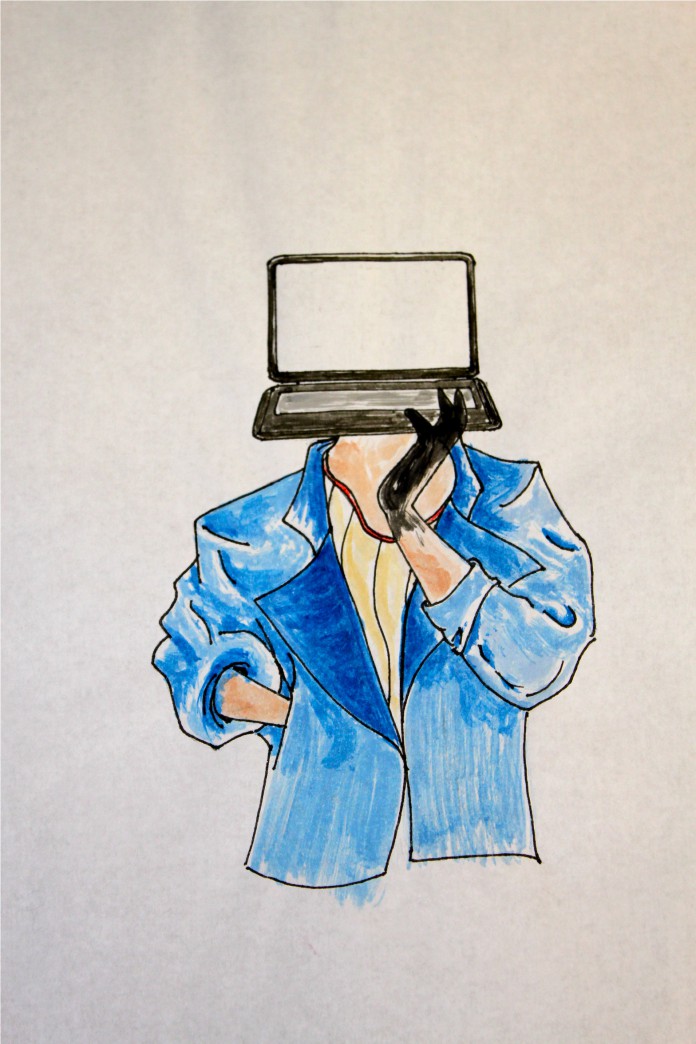Staff Writer
Photo by Andrea Rodriguez
Technology is the fastest changing key component of our lives. The computers we grew up with are now so obsolete they function better as paperweights and crappy versions of Legos for the new generation. Everyone has a cell phone and fewer and fewer people have home phones. Everyone has an email; no one checks their mail boxes.
For me personally, technology is a constant presence. Between Skyping my hometown boyfriend who now goes to school in Arizona, to keeping my family up to date via cell phone on life, I’m amazed I manage to balance without falling apart. Technology is as much a part of me as my hair; it may change appearance, but, day after day, it’s pretty much the same thing.
Technology just works for me. Over break at my mother’s with no Internet connection, I was reduced to spending far too much money at Starbucks simply because they wouldn’t give me the passwords to their Wi-Fi without a caffè latte in my hand.
With this, technology is changing our social lives. As it grows, so does our interconnectedness. Talking to people across the country is now as easy, if not easier, than talking to your neighbor. If you’re like me, you have no idea who your neighbors are back home. All I know is they glare at me every time I get the mail and that’s more than enough.
Technology allows us to stay connected across city, state and even national lines. We can support rebels in Egypt from the comfort of the lecture hall where we’re supposedly learning English.
James Fowler, a political science professor at University of California San Diego, summarized technology as “Instead of simply knowing who our friends are, and perhaps our friends’ friends, we can peer beyond our social horizon and see our place in a vast worldwide social network.”
Through the Internet, we can feel tied to humanity as a whole, crossing political, social and ethnic lines to connect and discuss.
For those separated by miles from those we love (in my case, 600 very long miles), technology offers us the best possible way to ease the loneliness and connect with people we’d otherwise lose to distance. Skype has become so commonplace on my desktop, it opens itself up the second I press the power button. It helps to ease the burden of separation, making transitions less stressful. Even if it doesn’t quite make up for face to face contact, it’s a good substitute until it’s possible to be together.
Every University of California Santa Barbara student has used technology to keep in touch with family members determined to know every single detail of our lives. It’s not uncommon for someone to hurriedly shush their Skype as it goes off in the middle of the library or to glare at that one girl who just had to answer her phone and couldn’t take her loud voice outside.
Balance, fellow college sufferers, is the key to everything. Passing class. Surviving weekends in IV without “those” photos on Facebook: it’s all balance. Technology can kill you or save you; just depends on how you work it.
The existence of advanced technology isn’t the issue here. Having a cell phone does not mean you have to be permanently attached to the little piece of metal and plastic. Blaming technology for decreasing social interaction is like blaming McDonald’s for 300 pound ?fth graders; it’s always nice to have a scapegoat, right? No one is forcing society to ignore each other; we’ve got to take responsibilities for our own actions.
People still meet for study groups and still go to parties. If anything, technology makes it easier to coordinate these things. If you’d rather hide behind an anonymous chat room window pretending the universe doesn’t like you enough to allow you real friends, that’s your decision and I’m sure you’ll be the next great inventor of the Facebook rip-off. I’ll stick to using my computer to keep my life organized, help me connect with the people I miss getting to see, and playing video games when everybody’s too busy. It works perfectly ?ne for me. Additional parts and negative side effects not included.









[…] http://thebottomline.as.ucsb.edu/2012/01/technology-is-in-your-face-is-that-so-bad […]
The technology is taking over your brain! Maybe you should learn to meditate. 🙂
By the way, check out my SuperFoods blog.
Comments are closed.